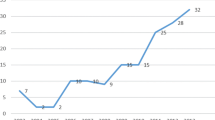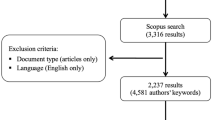Abstract
In order to explore new scientific and innovative communities, analyses based on a technological infrastructure and its related tools, for example, ‘Web of science’ database for Scientometric analysis, are necessary. However, there is little systematic documentation of social media data and webometric analysis in relation to Korean and broader Asian innovation communities. In this short communication, we present (1) webometric techniques to identify communication processes on the Internet, such as social media data collection and analysis using an API-based application; and (2) experimentation with new types of data visualization using NodeXL, such as social and semantic network analysis. Our research data is drawn from the social networking site, Twitter. We also examine the overlap between innovation communities in terms of their shared members, and then, (3) calculate entropy values for trilateral relationships.





Similar content being viewed by others
Notes
While all replies are mentions, not all mentions are replies (Barash and Golder 2010). Replies are shown to third parties only when they follow both users, i.e., the one who sent the Tweet and the other who replied.
For a more detailed explanation, please refer to the full Wikipedia entry http://en.wikipedia.org/wiki/Application_programming_interface.
For detailed information about the FullText software, please visit http://www.leydesdorff.net/software/fulltext/index.htm.
CONCOR correlates each pair of actors in terms of the vector of similarities and partitions data into different groups based on these correlations. For detailed explanation, please see http://www.faculty.ucr.edu/~hanneman/nettext/C13_%20Structural_Equivalence.html#concor.
This period was selected as being the most recent date which was not affected by national holidays and/or vacation seasons.
According to Java et al. (2007), Twitter users can be categorized into three groups—information providers, friends, and information seekers—based on the number of followers and followings.
References
Aguillo, I. F., Ortega, J. L., Fernández, M., & Utrilla, A. M. (2010). Indicators for a webometric ranking of open access repositories. Scientometrics, 82(3), 477–486.
Barash, V., & Golder, S. (2010). Twitter: Conversation, entertainment, and information, All in one network! Ch 10. In D. Hansen, B. Shneiderman & M. A. Smith. (Eds.), Analyzing social media networks with NodeXL: Insights from a connected world. MA: Morgan Kaufmann.
Björneborn, L., & Ingwersen, P. (2001). Perspective of webometrics. Scientometrics, 50(1), 65–82.
Burt, R. S. (2004). Structural holes and good ideas. American Journal of Sociology, 110(2), 349–399.
Doerfel, M. L., & Barnett, G. A. (1999). A semantic network analysis of the International Communication Association. Human Communication Research, 25(4), 589–603.
Etzkowitz, H. (2008). The Triple Helix: University–industry–government innovation in action. New York: Routledge.
Hansen, D., Shneiderman, B., & Smith, M. A. (2010). Analyzing social media networks with NodeXL: Insights from a connected world. MA: Morgan Kaufmann.
Hansen, D., Smith, M. A., & Shneiderman, B. (2011). Event graphs: Charting collections of conference connections. A paper presented to the Hawaii International Conference on System Science, Hawaii.
Holmberg, K. (2010). Co-inlinking to a municipal web space: A webometric and content analysis. Scientometrics, 83(3), 851–862.
Hughes, A. L., & Palen, L. (2010). Twitter adoption and use in mass convergence and emergency events. International Journal of Emergency Management, 6(3–4), 248–260.
Jansen, B. J., Zhang, M., Sobel, K., & Chowdury, A. (2009). Twitter power: Tweets as electronic word of mouth. Journal of the American Society for Information Science and Technology, 60(11), 2169–2188.
Java, A., Song, X., Finin, T., & Tseng, B. (2007). Why we twitter: Understanding microblogging usage and communities. Proceedings of the Joint 9th WEBKDD and 1st SNA-KDD Workshop 2007.
Lang, P., Gouveia, F. C., & Leta, J. (2010). Site co-link analysis applied to small networks: A new methodological approach. Scientometrics, 83(1), 157–166.
Leavitt, A., Burchard, E., Fisher, D., & Gilbert, S. (2009). The influentials: New approaches for analyzing influence on Twitter. Cambridge: Web Ecology Project.
Lenhart, A., & Fox, S. (2009). Twitter and status updating. Washington DC: Pew Internet & American Life Project.
Leydesdorff, L. (2003). The mutual information of university–industry–government relations: An indicator of the Triple Helix dynamics. Scientometrics, 58(2), 445–467.
Leydesdorff, L. (2006). The knowledge-based economy: Modeled, measured, simulated. Boca Raton: Universal-Publishers.
Must, U. (2006). “New”countries in Europe—Research, development and innovation strategies vs. bibliometric data. Scientometrics, 66(2), 241–248.
Park, H. W., & Leydesdorff, L. (2010). Longitudinal trends in networks of university–industry–government relations in South Korea: The role of programmatic incentives. Research Policy, 39(5), 640–649.
Ramos-Vielba, I., Fernández-Esquinas, M., & Espinosa-de-los-Monteros, E. (2009). Measuring university–industry collaboration in a regional innovation system. Scientometrics, 84(3), 649–667.
Sams, S., Lim, Y. S., & Park, H. W. (2011 forthcoming). E-research applications for tracking online socio-political capital in the Asia-Pacific region. Asian Journal of Communication, 21(3).
Simmel, G. (1971). The stranger. In D. N. Levine (Ed.), Georg simmel: On individuality and social forms (pp. 143–150). Chicago: University of Chicago Press.
Theil, H. (1972). Statistical decomposition analysis: With applications in the social and administrative sciences. Amsterdam: North-Holland.
Thelwall, M. (2009). Introduction to webometrics: Quantitative web research for the social sciences. CA: Morgan & Claypool.
Yu, J., Russell, M. G., Still, K., Rubens, N., Huhtamäki, J., & Pöschko, J. (2011). Social media, reputation and branding of innovation hubs: A periscope using content analysis of Twitter. Presented at the Triple Helix IX Conference on July 14, 2011.
Zabala-Iturriagagoitia, J. M., Jimenez-Saez, F., Castro-Martinez, E., & Gutierrez-Gracia, A. (2007). What indicators do (or do not) tell us about regional innovation systems. Scientometrics, 70(1), 85–106.
Zhao, D., & Rosson, M. B. (2009). How and why people Twitter: The role that micro-blogging plays in informal communication at work. Proceedings of the ACM 2009 international conference on supporting group.
Acknowledgments
The authors are grateful to colleagues in the WCU Webometrics Institute for their valuable comments on an earlier version of this paper that was presented at the SunBelt Social Networks Conference in February 2011, prior to extensive modification with different research questions. This research was partly supported by the WCU (World Class University) program of the National Research Foundation of Korea, funded by the Ministry of Education, Science and Technology (No. 515-82-06574) (http://www.webometrics.yu.ac.kr).
Author information
Authors and Affiliations
Corresponding author
Appendix
Rights and permissions
About this article
Cite this article
Choi, S., Park, Jy. & Park, H.W. Using social media data to explore communication processes within South Korean online innovation communities. Scientometrics 90, 43–56 (2012). https://doi.org/10.1007/s11192-011-0514-7
Received:
Published:
Issue Date:
DOI: https://doi.org/10.1007/s11192-011-0514-7




